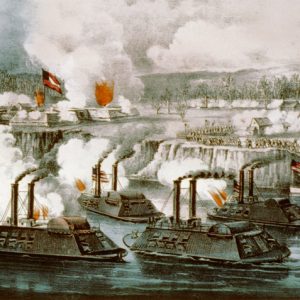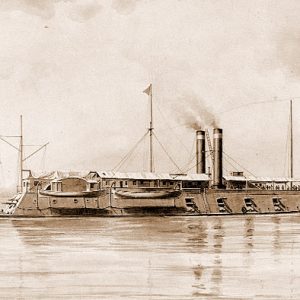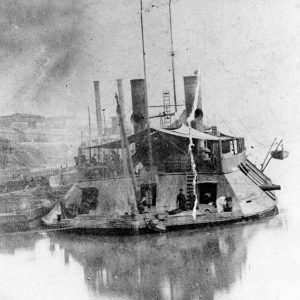calsfoundation@cals.org
USS Louisville
The USS Louisville was a Federal ironclad gunboat that saw service on rivers in the Western Theater during the Civil War, including in Arkansas.
The Louisville and other ironclads in the Western Theater were constructed to be part of the Union navy’s blockade of the Confederacy. By taking control of the Mississippi River, Federal forces would effectively cut the Trans-Mississippi off from the rest of the Confederacy and help starve both sides economically. To help accomplish this task, an inland naval flotilla was established in the North to join additional Union ships moving up the Mississippi River.
The Louisville was a City-class ironclad constructed by James Eads at Carondelet, Missouri. Under contract with the War Department, Eads began construction of the vessel in 1861. The boat was accepted by the government on January 16, 1862, and commissioned the next day under the command of Commander Benjamin Dove.
The City-class gunboats were designed to fight head on, carrying three guns in the bow with four on each broadside and two aft. The original armament of the Louisville included three eight-inch smoothbore guns, four forty-two-pound rifled guns, six thirty-two-pound rifled guns, and one twelve-pound boat howitzer that could be easily moved. This armament changed over the course of the war, and the final complement of guns included a 100-pound rifle. Iron plates 2.5 inches thick covered the forward casemate and the engines to protect the vessel from enemy fire.
The Louisville joined the naval forces on the Cumberland River in February 1862 and took on the crew of the USS Cairo as their boat underwent repairs. The flotilla attacked Fort Donelson, Tennessee, on February 14, and the Louisville was struck thirty-six times. The tiller on the boat was shot away, and the Louisville drifted out of the battle; four men were killed and five wounded.
The Louisville next served at Columbus, Kentucky, to help prevent a Confederate attack on the town. The boat was involved in the campaign to capture Island Number 10 and New Madrid, Missouri, before steaming to Fort Pillow, Tennessee. The Louisville and other Federal boats moved to Memphis, Tennessee, where they defeated a Confederate flotilla on June 6, 1862. Later that month, the Louisville engaged several batteries north of Vicksburg, Mississippi, before moving to Helena (Phillips County), where the boat began operations in Arkansas. A small fleet of gunboats and transports moved into the White River, but the water proved to be too shallow for a long expedition.
In October 1862, the Louisville participated in a retaliatory attack on guerrillas at Bledsoe’s Landing, Arkansas. On December 1, Lieutenant Robert Riley took command of the boat. The Louisville participated in the capture of Fort Hindman in January 1863, under the command of Lieutenant Elias Owen. The boat directly engaged enemy batteries on January 10 with the USS Baron de Kalb and the USS Cincinnati, having three men killed or mortally wounded and eight wounded. The boat dropped out of range of the enemy guns after about two hours and prepared to attack again. On January 11, the Louisville once again shelled the fort, which surrendered late that afternoon. Three sailors on the Louisville were later awarded the Medal of Honor for service in the battle.
Next seeing service around Vicksburg, the Louisville worked with the USS Pittsburg, USS Mound City, and USS Carondolet on April 29 to neutralize the fortifications at Grand Gulf. From March to May 1864, the Louisville served in the Red River Campaign in Louisiana. After the Union forces failed to capture Shreveport, Louisiana, the forces retreated back to the Mississippi River. Moving back to Arkansas, the Louisville faced off against enemy batteries near Columbia (Chicot County) on June 2, 1864. Part of the flotilla that carried troops to participate in the Engagement at Old River Lake on June 6, 1864, the Louisville also participated in an action near Gaines’ Landing later that month.
The Louisville continued to serve in the fleet until it was decommissioned on July 21, 1865. The boat was sold in Mound City, Illinois, on November 29, 1865, and the final disposition of the vessel is unknown.
For additional information:
Dictionary of American Naval Fighting Ships. Washington DC: Navy Department, Office of the Chief of Naval Operations, Naval History Division, 1959–1981.
Official Records of the Union and Confederate Navies in the War of the Rebellion. Series I, Volumes 22–26, Washington DC: Government Printing Office, 1921.
David Sesser
Henderson State University
 Civil War through Reconstruction, 1861 through 1874
Civil War through Reconstruction, 1861 through 1874 Military
Military ACWSC Logo
ACWSC Logo  Battle of Arkansas Post
Battle of Arkansas Post  USS Louisville
USS Louisville  USS Louisville
USS Louisville 




Comments
No comments on this entry yet.